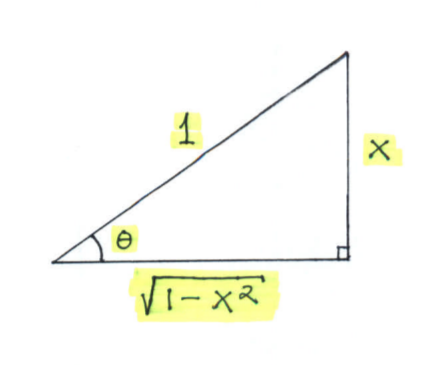SOLUTION 3: $ \ \ $ To integrate $ \displaystyle{ \int { 1
\over (1-x^2)^{3/2} } \ dx } $ use the trig substitution
$$ x = \sin \theta $$
so that
$$ dx = \cos \theta \ d \theta $$
Substitute into the original problem, replacing all forms of $ x $, getting
$$ \displaystyle { \int \frac{1}{(1-x^{2})^{3/2}} \ dx = \int
\frac{1}{(1-\sin^{2} \theta)^{3/2}} \ \cos \theta \ d \theta } $$
$$ = \displaystyle { \int \frac{1}{(\cos^{2} \theta)^{3/2}} \ \cos
\theta \ d \theta } $$
$$ = \displaystyle { \int \frac{1}{\cos^{3} \theta} \ \cos \theta \
d \theta } $$
$$ = \displaystyle { \int \frac{1}{\cos^{2} \theta} \ d \theta } $$
$$ = \displaystyle { \int \sec^{2} \theta \ d \theta } $$
$$ = \tan \theta + C $$
$\Big($ We need to write our final answer in terms of $x$.

Since $ x = \sin \theta $ it follows that
$$ \sin \theta = \displaystyle{ x \over 1 } = \displaystyle{ opposite \over hypotenuse } $$
and from the Pythagorean Theorem that
$$ \displaystyle (adjacent)^2 + (opposite)^2 = (hypotenuse)^2
\ \ \longrightarrow $$
$$ (adjacent)^2 + (x)^2 = (1)^2
\ \ \longrightarrow \ \ \ adjacent = \sqrt{1-x^2} \ \ \longrightarrow $$
$$ \tan \theta = \displaystyle{ opposite \over adjacent }= \displaystyle{ x \over \sqrt{1-x^2} } . \Big) $$
$$ = \displaystyle{ x \over \sqrt{1-x^2} } + C $$
Click HERE to return to the list of problems.

